
《工业设计概论》课程教学大纲 Syllabus for The General Introduction of Industrial Design) 课程编号:012012 Course Code:012012 课程名称:工业设计概论 Course Title:The General Introduction of Industrial Design 课程类型:专业基础课 Course Nature:Professional basic course 总学时(Credit Hours):32 学分(Credit):2 适用对象:工业设计专业本科学生 Suitable for:Undergraduate students of industrial design 先修课程:素描、色彩、平面构成 Prerequisite Courses:Sketch,Color,Plane Composition 后续课程:人机工程学、产品语义学 Follow-up courses:Ergonomics,Product Semantic 开课单位:郑州大学机械与动力工程学院 Department:School of Mechanical and Power Engineering,Zhengzhou University 一、课程性质和教学目标 《工业设计概论》是工业设计专业的学科基础必修课,是工业设计的专业入门课。课程主要探讨工 业设计与设计的定义与内涵,工业设计研究的范畴,工业设计的现状与发展历史,工业设计与文化、 艺术的关系,工业设计与技术的关系,工业设计与相关学科的关系,工业设计的特征与设计原则等。 本课程的任务是通过课程的学习,使学生对工业设计有深入、全面的认识:使学生对工业设计专 业有比较详细的了解,让其知道工业设计是什么、学习什么、如何学习、如何成为合格的设计师:为 工业设计其他课程的开展奠定基础。 1.Nature of Curriculum and Teaching Objectives (The General Introduction of Industrial Design is a basic compulsory course for Industrial Design Discipline,and it is also an introductory course for Industrial Design Discipline. The course mainly discusses the definition and connotation of industrial design and design the scope of industrial design research,the current situation and development history of industrial design,the relationship between industrial design and culture,art,technology related disciplines,and the characteristics and principles of Industrial Design. The task of this course is to make students have a deep and comprehensive understanding of Industrial Design:To enable students to have a more detailed understanding of industrial
《 工业设计概论 》课程教学大纲 Syllabus for 《The General Introduction of Industrial Design》 课程编号:012012 Course Code: 012012 课程名称: 工业设计概论 Course Title:The General Introduction of Industrial Design 课程类型:专业基础课 Course Nature: Professional basic course 总 学 时(Credit Hours):32 学 分(Credit):2 适用对象: 工业设计专业本科学生 Suitable for: Undergraduate students of industrial design 先修课程:素描、色彩、平面构成 Prerequisite Courses: Sketch, Color, Plane Composition 后续课程:人机工程学、产品语义学 Follow-up courses: Ergonomics, Product Semantic 开课单位:郑州大学机械与动力工程学院 Department: School of Mechanical and Power Engineering, Zhengzhou University 一、课程性质和教学目标 《工业设计概论》是工业设计专业的学科基础必修课,是工业设计的专业入门课。课程主要探讨工 业设计与设计的定义与内涵,工业设计研究的范畴,工业设计的现状与发展历史,工业设计与文化、 艺术的关系,工业设计与技术的关系,工业设计与相关学科的关系,工业设计的特征与设计原则等。 本课程的任务是通过课程的学习,使学生对工业设计有深入、全面的认识;使学生对工业设计专 业有比较详细的了解,让其知道工业设计是什么、学习什么、如何学习、如何成为合格的设计师;为 工业设计其他课程的开展奠定基础。 I.Nature of Curriculum and Teaching Objectives 《The General Introduction of Industrial Design》is a basic compulsory course for Industrial Design Discipline, and it is also an introductory course for Industrial Design Discipline. The course mainly discusses the definition and connotation of industrial design and design, the scope of industrial design research, the current situation and development history of industrial design, the relationship between industrial design and culture, art, technology, related disciplines, and the characteristics and principles of Industrial Design. The task of this course is to make students have a deep and comprehensive understanding of Industrial Design ; To enable students to have a more detailed understanding of industrial
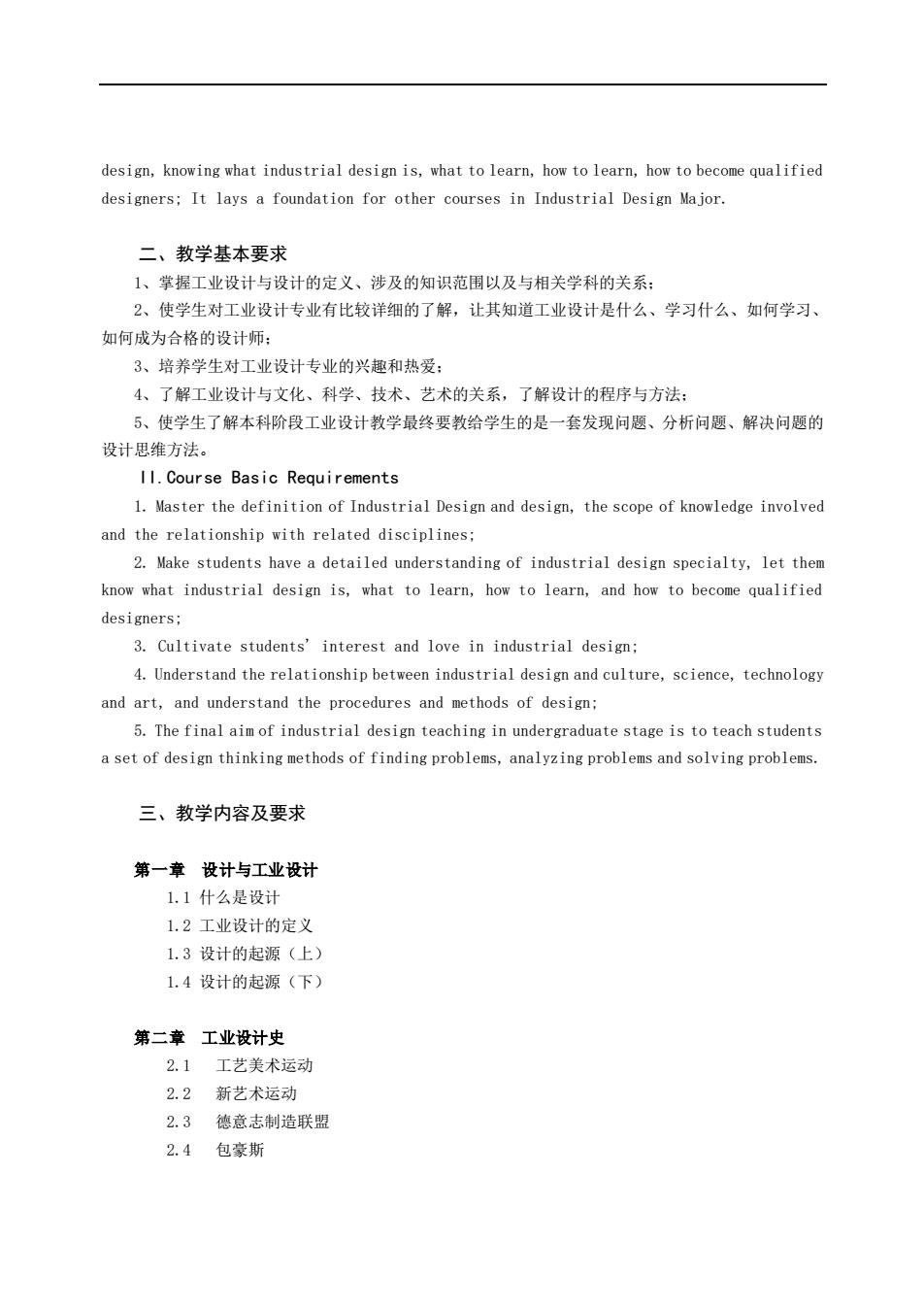
design,knowing what industrial design is,what to learn,how to learn,how to become qualified designers:It lays a foundation for other courses in Industrial Design Major. 二、教学基本要求 1、掌握工业设计与设计的定义、涉及的知识范围以及与相关学科的关系 2、使学生对工业设计专业有比较详细的了解,让其知道工业设计是什么、学习什么、如何学习、 如何成为合格的设计师: 3、培养学生对工业设计专业的兴趣和热爱: 4、了解工业设计与文化、科学、技术、艺术的关系,了解设计的程序与方法: 5、使学生了解本科阶段工业设计教学最终要教给学生的是一套发现问题、分析问题、解决问题的 设计思维方法。 I1.Course Basic Requirements 1.Master the definition of Industrial Design and design,the scope of knowledge involved and the relationship with related disciplines: 2.Make students have a detailed understanding of industrial design specialty,let them know what industrial design is,what to learn,how to learn,and how to become qualified designers; 3.Cultivate students'interest and love in industrial designa 4.Understand the relationship between industrial design and culture,science,technology and art,and understand the procedures and methods of design: 5.The final aim of industrial design teaching in undergraduate stage is to teach students a set of design thinking methods of finding problems,analyzing problems and solving problems. 三、教学内容及要求 第一章设计与工业设计 1.1什么是设计 1.2工业设计的定义 1.3设计的起源(上) 1.4设计的起源(下) 第二章工业设计史 2.1工艺美术运动 2.2新艺术运动 2.3德意志制造联盟 2.4包豪斯
design, knowing what industrial design is, what to learn, how to learn, how to become qualified designers; It lays a foundation for other courses in Industrial Design Major. 二、教学基本要求 1、掌握工业设计与设计的定义、涉及的知识范围以及与相关学科的关系; 2、使学生对工业设计专业有比较详细的了解,让其知道工业设计是什么、学习什么、如何学习、 如何成为合格的设计师; 3、培养学生对工业设计专业的兴趣和热爱; 4、了解工业设计与文化、科学、技术、艺术的关系,了解设计的程序与方法; 5、使学生了解本科阶段工业设计教学最终要教给学生的是一套发现问题、分析问题、解决问题的 设计思维方法。 II.Course Basic Requirements 1. Master the definition of Industrial Design and design, the scope of knowledge involved and the relationship with related disciplines; 2. Make students have a detailed understanding of industrial design specialty, let them know what industrial design is, what to learn, how to learn, and how to become qualified designers; 3. Cultivate students' interest and love in industrial design; 4. Understand the relationship between industrial design and culture, science, technology and art, and understand the procedures and methods of design; 5. The final aim of industrial design teaching in undergraduate stage is to teach students a set of design thinking methods of finding problems, analyzing problems and solving problems. 三、教学内容及要求 第一章 设计与工业设计 1.1 什么是设计 1.2 工业设计的定义 1.3 设计的起源(上) 1.4 设计的起源(下) 第二章 工业设计史 2.1 工艺美术运动 2.2 新艺术运动 2.3 德意志制造联盟 2.4 包豪斯

2.5流线型风格 2.6 德国设计 2.7 意大利设计 2.8 美国设计 2.9斯堪的纳维亚设计 2.10日本设计 2.11多元化设计风格 2.12信息时代的工业设计 第三章设计与相关学科 3.1工业设计与市场 3.2设计与材料 3.3 设计与新材料 3.4设计与技术 3.5 设计与符号学 3.6设计与文化 3.7 设计与形态学 3.8设计与美学 3.9 工业设计与环境 第四章工业设计方法论 4.1工业设计的特征 4.2 工业设计的原则 4.3 工业设计的创新方法 第五章工业设计的领域 5.1产品设计 5.2视觉传达设计 5.3环境设计 第六章设计欣赏 6.1世界三大设计奖项 6.2设计大师作品欣赏 第七章设计畅谈 7.1设计奇葩大会
2.5 流线型风格 2.6 德国设计 2.7 意大利设计 2.8 美国设计 2.9 斯堪的纳维亚设计 2.10 日本设计 2.11 多元化设计风格 2.12 信息时代的工业设计 第三章 设计与相关学科 3.1 工业设计与市场 3.2 设计与材料 3.3 设计与新材料 3.4 设计与技术 3.5 设计与符号学 3.6 设计与文化 3.7 设计与形态学 3.8 设计与美学 3.9 工业设计与环境 第四章 工业设计方法论 4.1 工业设计的特征 4.2 工业设计的原则 4.3 工业设计的创新方法 第五章 工业设计的领域 5.1 产品设计 5.2 视觉传达设计 5.3 环境设计 第六章 设计欣赏 6.1 世界三大设计奖项 6.2 设计大师作品欣赏 第七章 设计畅谈 7.1 设计奇葩大会
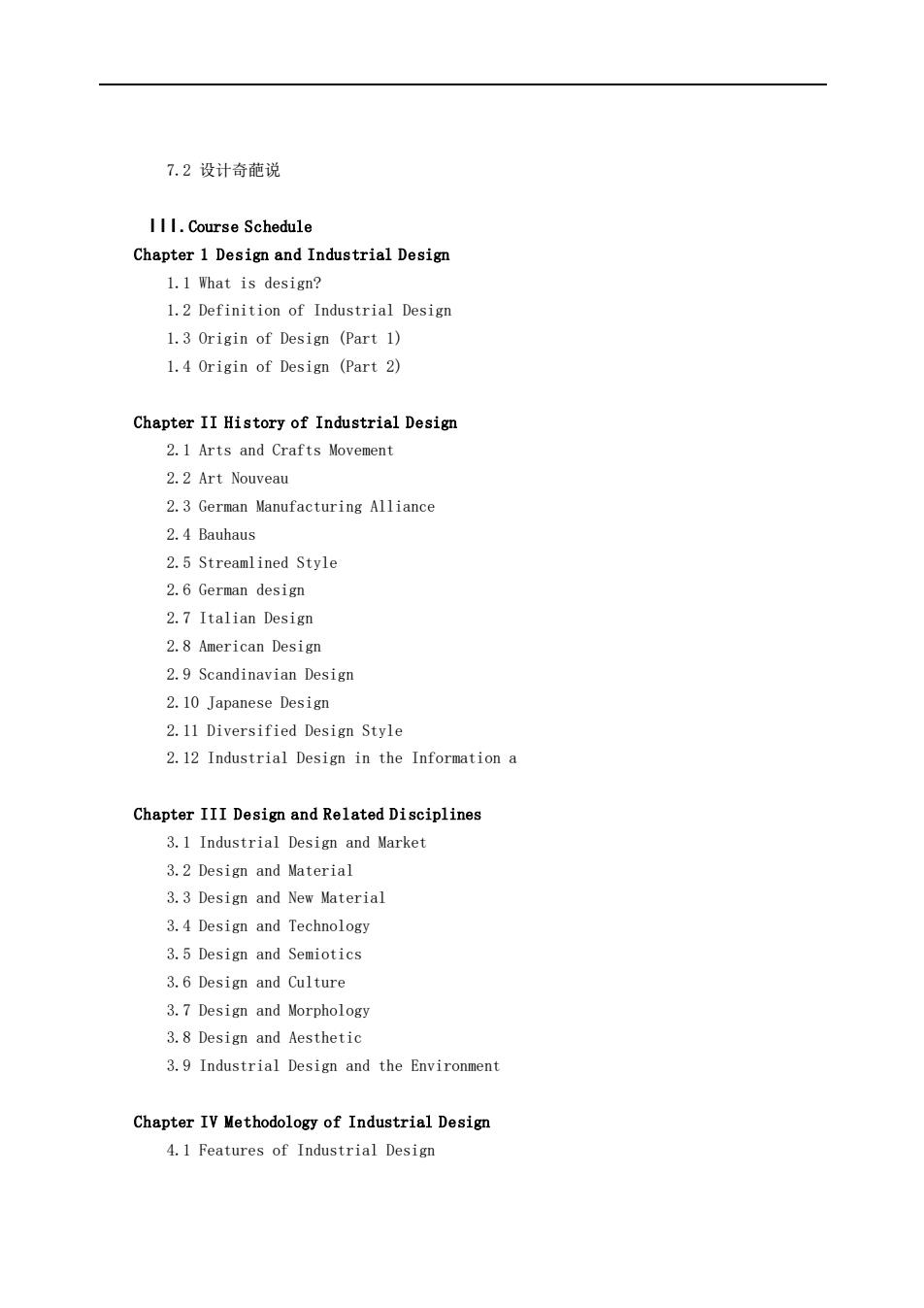
7.2设计奇葩说 111.Course Schedule Chapter 1 Design and Industrial Design 1.1 What is design? 1.2 Definition of Industrial Design 1.3 Origin of Design (Part 1) 1.4 Origin of Design (Part 2) Chapter II History of Industrial Design 2.1 Arts and Crafts Movement 2.2 Art Nouveau 2.3 German Manufacturing Alliance 2.4 Bauhaus 2.5 Streamlined Style 2.6 German design 2.7 Italian Design 2.8 American Design 2.9 Scandinavian Design 2.10 Japanese Design 2.11 Diversified Design Style 2.12 Industrial Design in the Information a Chapter III Design and Related Disciplines 3.1 Industrial Design and Market 3.2 Design and Material 3.3 Design and New Material 3.4 Design and Technology 3.5 Design and Semiotics 3.6 Design and Culture 3.7 Design and Morphology 3.8 Design and Aesthetic 3.9 Industrial Design and the Environment Chapter IV Methodology of Industrial Design 4.1 Features of Industrial Design
7.2 设计奇葩说 III.Course Schedule Chapter 1 Design and Industrial Design 1.1 What is design? 1.2 Definition of Industrial Design 1.3 Origin of Design (Part 1) 1.4 Origin of Design (Part 2) Chapter II History of Industrial Design 2.1 Arts and Crafts Movement 2.2 Art Nouveau 2.3 German Manufacturing Alliance 2.4 Bauhaus 2.5 Streamlined Style 2.6 German design 2.7 Italian Design 2.8 American Design 2.9 Scandinavian Design 2.10 Japanese Design 2.11 Diversified Design Style 2.12 Industrial Design in the Information a Chapter III Design and Related Disciplines 3.1 Industrial Design and Market 3.2 Design and Material 3.3 Design and New Material 3.4 Design and Technology 3.5 Design and Semiotics 3.6 Design and Culture 3.7 Design and Morphology 3.8 Design and Aesthetic 3.9 Industrial Design and the Environment Chapter IV Methodology of Industrial Design 4.1 Features of Industrial Design
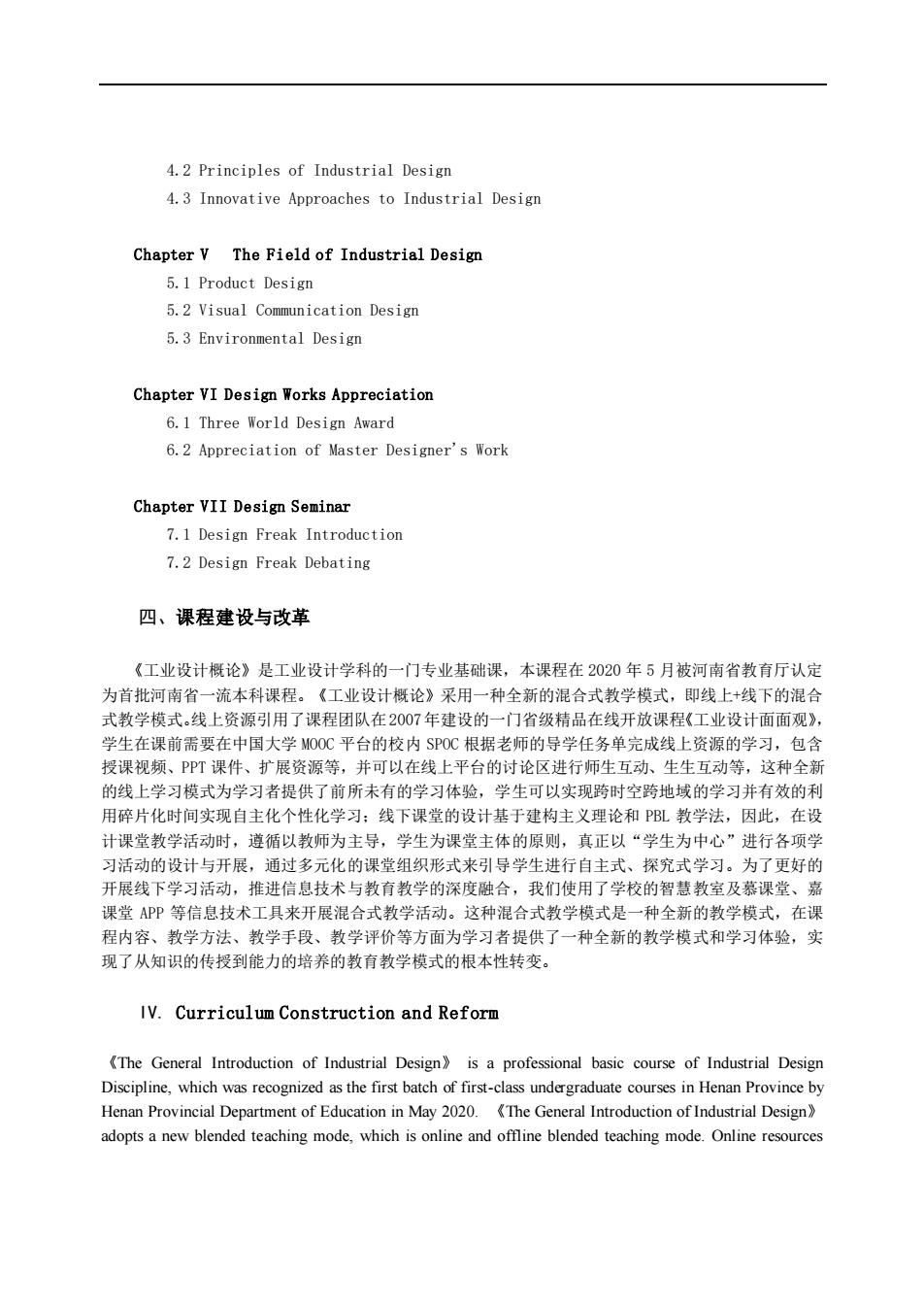
4.2 Principles of Industrial Design 4.3 Innovative Approaches to Industrial Design Chapter V The Field of Industrial Design 5.1Product Design 5.2 Visual Communication Design 5.3 Environmental Design Chapter VI Design Works Appreciation 6.1 Three World Design Award 6.2 Appreciation of Master Designer's Work Chapter VII Design Seminar 7.1 Design Freak Introduction 7.2 Design Freak Debating 四、课程建设与改革 《工业设计播论》是工业设计学科的一门专业基础误,本课程在2020年5月被河南省教有厅认瑞 为首批河南省一流本科课程。 《工业设计概论》采用一种全新的混合式教学模式,即线上+线下的混 式教学模式.线上资源引用了课程团队在2007年建设的一门省级精品在线开放课程《工业设计面面观》 学生在课前需要在中国大学M00C平台的校内SPOC根据老师的导学任务单完成线上资源的学习,包含 授课视频、PPT课件、扩展资源等,并可以在线上平台的讨论区进行师生互动、生生互动等,这种全新 的线上学习模式为学习者提供了前所未有的学习体验,学生可以实现跨时空跨地域的学习并有效的利 用碎片化时间实现自主化个性化学习:线下课堂的设计基于建构主义理论和PL教学法,因此,在设 计课堂教学活动时,遵循以教师为主导,学生为课堂主体的原则,真正以“学生为中心”进行各项号 习活动的设计与开展,通过多元化的课堂组织形式来引导学生进行自主式、探究式学习。为了更好的 开展线下学习活动,推进信总技术与教育教学的深度融合,我们使用了学校的智慧教室及慕课堂、嘉 课堂APP等信息技术工具来开展混合式教学活动。这种混合式教学模式是一种全新的教学模式,在课 程内容、教学方法、教学手段、教学评价等方面为学习者提供了一种全新的教学模式和学习体验,实 从知识的传授到能力的培养的教育教学模式的根本性转变 IV.Curriculum Construction and Reform The General Introduction of Industrial Design is a professional basic course of Industrial Design Discipline,which was recognized as the first batch of first-class undergraduate courses in Henan Province by Henan Provincial Department of Education in May 2020.The General Introduction of Industrial Design adopts a new blended teaching mode,which is online and offline blended teaching mode.Online resources
4.2 Principles of Industrial Design 4.3 Innovative Approaches to Industrial Design Chapter V The Field of Industrial Design 5.1 Product Design 5.2 Visual Communication Design 5.3 Environmental Design Chapter VI Design Works Appreciation 6.1 Three World Design Award 6.2 Appreciation of Master Designer's Work Chapter VII Design Seminar 7.1 Design Freak Introduction 7.2 Design Freak Debating 四、课程建设与改革 《工业设计概论》是工业设计学科的一门专业基础课,本课程在 2020 年 5 月被河南省教育厅认定 为首批河南省一流本科课程。《工业设计概论》采用一种全新的混合式教学模式,即线上+线下的混合 式教学模式。线上资源引用了课程团队在2007年建设的一门省级精品在线开放课程《工业设计面面观》, 学生在课前需要在中国大学 MOOC 平台的校内 SPOC 根据老师的导学任务单完成线上资源的学习,包含 授课视频、PPT 课件、扩展资源等,并可以在线上平台的讨论区进行师生互动、生生互动等,这种全新 的线上学习模式为学习者提供了前所未有的学习体验,学生可以实现跨时空跨地域的学习并有效的利 用碎片化时间实现自主化个性化学习;线下课堂的设计基于建构主义理论和 PBL 教学法,因此,在设 计课堂教学活动时,遵循以教师为主导,学生为课堂主体的原则,真正以“学生为中心”进行各项学 习活动的设计与开展,通过多元化的课堂组织形式来引导学生进行自主式、探究式学习。为了更好的 开展线下学习活动,推进信息技术与教育教学的深度融合,我们使用了学校的智慧教室及慕课堂、嘉 课堂 APP 等信息技术工具来开展混合式教学活动。这种混合式教学模式是一种全新的教学模式,在课 程内容、教学方法、教学手段、教学评价等方面为学习者提供了一种全新的教学模式和学习体验,实 现了从知识的传授到能力的培养的教育教学模式的根本性转变。 IV. Curriculum Construction and Reform 《The General Introduction of Industrial Design》 is a professional basic course of Industrial Design Discipline, which was recognized as the first batch of first-class undergraduate courses in Henan Province by Henan Provincial Department of Education in May 2020. 《The General Introduction of Industrial Design》 adopts a new blended teaching mode, which is online and offline blended teaching mode. Online resources
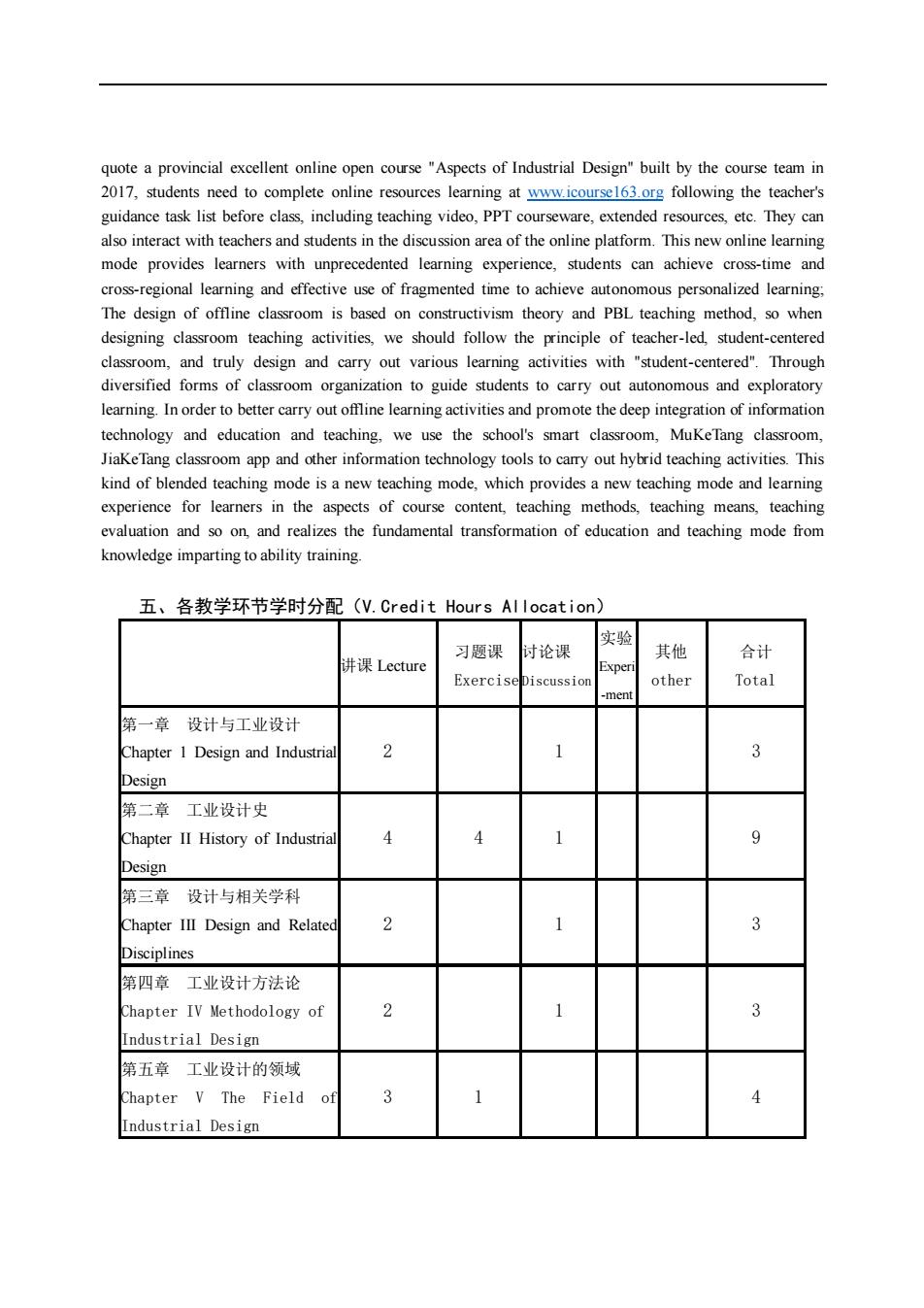
quote a provincial excellent online open course "Aspects of Industrial Design"built by the course team in 2017.students need to complete online resources learning at wwwicourse63org following the teacher's They can also interact with teachers and students in the discussion area of the online platform.This new online learning mode provides learners with unprecedented learning experience,students can achieve cross-time and cross-regional learning and effective use of fragmented time to achieve autonomous personalized learning. The design of offline classroom is based on constructivism theory and PBL teaching method.so wher designing classroom teaching activities,we should follow the principle of teacher-led studer centered classroom and truly design and carry out variou withuent-entered Through diversified forms of classroom organization to guide students to carry out autonomous and exploratory learning.In order to better carry out offline learning activities and promote the deep integration of information technology and education and teaching.we use the school's smart classroom,MuKeTang classroom, JiaKeTang appand ter information ou hybrid teaching activities.This kind of blended teaching mode isa new eaching mode hich provides ing mode and lea experience for learners in the aspects of course content, ing methods,teaching means.teaching evaluation and so on,and realizes the fundamental transformation of education and teaching mode from knowledge imparting to ability training. 五、各教学环节学时分配(V.Credit Hours Allocation) 实验 其他 并课Lecture 习题课时论课 合计 Exercise iscussic other Total 意一意设计与工业设计 Chapter I Design and Industria 2 3 第二章工业设计史 apter II History of Industri 4 9 esign 第三章设计与相关学科 hapter III Design and Relate 2 Disciplines 第四章工业设计方法论 hapter IV Methodology of 9 Industrial Design 第五章工业设计的领域 hapter V The Field 0 1 ndustrial Design
quote a provincial excellent online open course "Aspects of Industrial Design" built by the course team in 2017, students need to complete online resources learning at www.icourse163.org following the teacher's guidance task list before class, including teaching video, PPT courseware, extended resources, etc. They can also interact with teachers and students in the discussion area of the online platform. This new online learning mode provides learners with unprecedented learning experience, students can achieve cross-time and cross-regional learning and effective use of fragmented time to achieve autonomous personalized learning; The design of offline classroom is based on constructivism theory and PBL teaching method, so when designing classroom teaching activities, we should follow the principle of teacher-led, student-centered classroom, and truly design and carry out various learning activities with "student-centered". Through diversified forms of classroom organization to guide students to carry out autonomous and exploratory learning. In order to better carry out offline learning activities and promote the deep integration of information technology and education and teaching, we use the school's smart classroom, MuKeTang classroom, JiaKeTang classroom app and other information technology tools to carry out hybrid teaching activities. This kind of blended teaching mode is a new teaching mode, which provides a new teaching mode and learning experience for learners in the aspects of course content, teaching methods, teaching means, teaching evaluation and so on, and realizes the fundamental transformation of education and teaching mode from knowledge imparting to ability training. 五、各教学环节学时分配(V.Credit Hours Allocation) 讲课 Lecture 习题课 Exercise 讨论课 Discussion 实验 Experi -ment 其他 other 合计 Total 第一章 设计与工业设计 Chapter 1 Design and Industrial Design 2 1 3 第二章 工业设计史 Chapter II History of Industrial Design 4 4 1 9 第三章 设计与相关学科 Chapter III Design and Related Disciplines 2 1 3 第四章 工业设计方法论 Chapter IV Methodology of Industrial Design 2 1 3 第五章 工业设计的领域 Chapter V The Field of Industrial Design 3 1 4
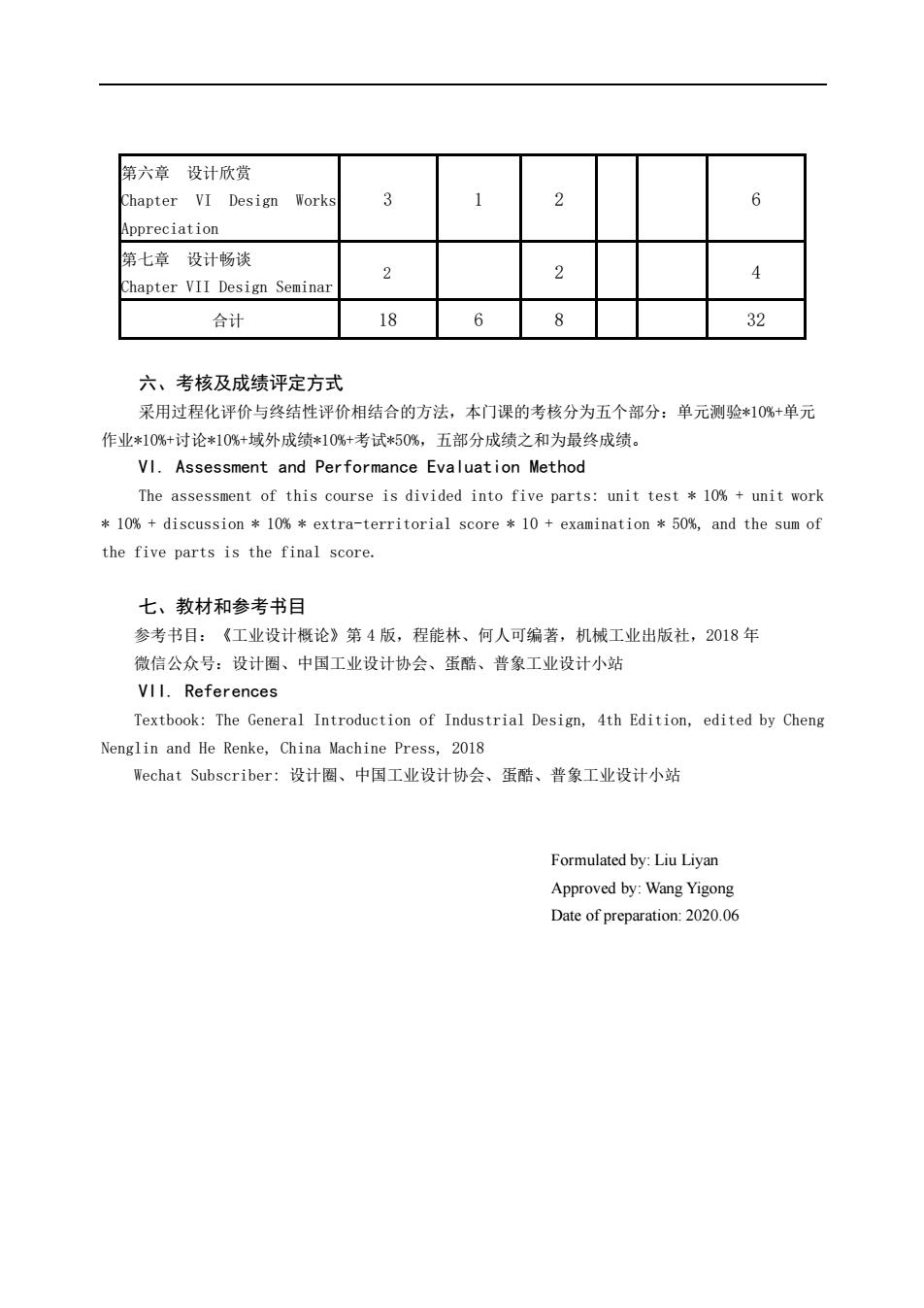
第六章设计欣赏 Chapter VI Design Work 6 ppreciation 第七章设计畅谈 2 4 hapter VII Design Seminar 合计 18 6 32 六、考核及成绩评定方式 采用过程化评价与终结性评价相结合的方法,本门课的考核分为五个部分:单元测验*10%+单元 作业*10%+讨论*10%+域外成绩*10%+考试*50%,五部分成绩之和为最终成绩。 VI.Assessment and Performance Evaluation Method The assessment of this course is divided into five parts:unit test *10%+unit work *10%+discussion *10%*extra-territorial score *10+examination 50%,and the sum of the five parts is the final score. 七、教材和参考书目 参考书目:《工业设计概论》第4版,程能林、何人可编著,机械工业出版社,2018年 微信公众号:设计圈、中国工业设计协会、蛋酷、普象工业设计小站 VII.References Textbook:The General Introduction of Industrial Design,4th Edition,edited by Cheng Nenglin and He Renke,China Machine Press,2018 Wechat Subscriber:设计圈、中国工业设计协会、蛋酷、普象工业设计小站 Formulated by:Liu Liyan Approved by:Wang Yigong Date of preparation:2020.06
第六章 设计欣赏 Chapter VI Design Works Appreciation 3 1 2 6 第七章 设计畅谈 Chapter VII Design Seminar 2 2 4 合计 18 6 8 32 六、考核及成绩评定方式 采用过程化评价与终结性评价相结合的方法,本门课的考核分为五个部分:单元测验*10%+单元 作业*10%+讨论*10%+域外成绩*10%+考试*50%,五部分成绩之和为最终成绩。 VI. Assessment and Performance Evaluation Method The assessment of this course is divided into five parts: unit test * 10% + unit work * 10% + discussion * 10% * extra-territorial score * 10 + examination * 50%, and the sum of the five parts is the final score. 七、教材和参考书目 参考书目:《工业设计概论》第 4 版,程能林、何人可编著,机械工业出版社,2018 年 微信公众号:设计圈、中国工业设计协会、蛋酷、普象工业设计小站 VII. References Textbook: The General Introduction of Industrial Design, 4th Edition, edited by Cheng Nenglin and He Renke, China Machine Press, 2018 Wechat Subscriber: 设计圈、中国工业设计协会、蛋酷、普象工业设计小站 Formulated by: Liu Liyan Approved by: Wang Yigong Date of preparation: 2020.06